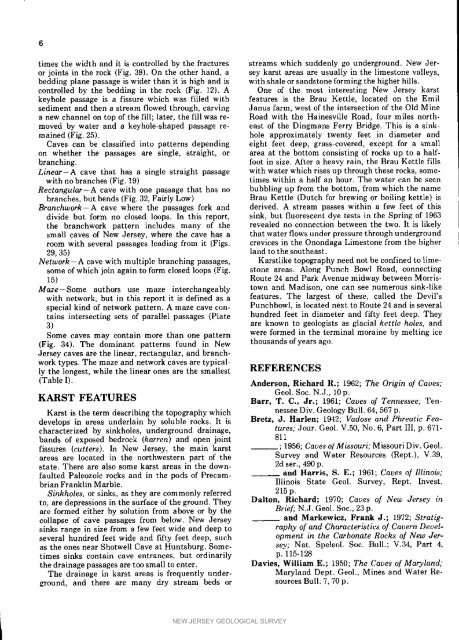Bulletin 70. Caves of New Jersey, 1976 - State of New Jersey
Bulletin 70. Caves of New Jersey, 1976 - State of New Jersey
Bulletin 70. Caves of New Jersey, 1976 - State of New Jersey
Create successful ePaper yourself
Turn your PDF publications into a flip-book with our unique Google optimized e-Paper software.
6<br />
times the width and it is controlled by the fractures streams which suddenly go underground. <strong>New</strong> Jeror<br />
joints in the rock (Fig. 38). On the other hand, a sey karst areas are usually in the limestone valleys,<br />
bedding plane passage is wider than it is high and is with shale or sandstone forming the higher hills.<br />
controlled by the bedding in the rock (Fig. 12). A One <strong>of</strong> the most interesting <strong>New</strong> <strong>Jersey</strong> karst<br />
keyhole passage is a fissure which was filled with features is the Brau Kettle, located on the Emil<br />
sediment and then a stream flowed through, carving Janus farm, west <strong>of</strong> the intersection <strong>of</strong> the Old Mine<br />
a new channel on top <strong>of</strong> the fill; later, the fill was re- Road with the Hainesville Road, four miles northmoved<br />
by water and a keyhole-shaped passage re- east <strong>of</strong> the Dingmans Ferry Bridge. This is a sinkmained<br />
(Fig. 25). hole approximately twenty feet in diameter and<br />
<strong>Caves</strong> can be classified into patterns depending eight feet deep, grass-covered, except for a small<br />
on whether the passages are single, straight, or area at the bottom consisting <strong>of</strong> rocks up to a halfbranching,<br />
foot in size. After a heavy rain, the Brau Kettle fills<br />
Linear- A cave that has a single straight passage with water which rises up through these rocks, somewith<br />
nobranches (Fig. 19) times within a half an hour. The water can be seen<br />
Rectangular-A cave with one passage that has no bubbling up from the bottom, from which the name<br />
branches, but bends (Fig. 32, Fairly Low) Brau Kettle (Dutch for brewing or boiling kettle) is<br />
Branchwork-A cave where the passages fork and derived. A stream passes within a few feet <strong>of</strong> this<br />
divide but form no closed loops. In this report, sink, but fluorescent dye tests in the Spring <strong>of</strong> 1963<br />
the branchwork pattern includes many <strong>of</strong> the revealed no connection between the two. It is likely<br />
small caves <strong>of</strong> <strong>New</strong> <strong>Jersey</strong>, where the cave has a that water flows under pressure through underground<br />
room with several passages leading from it (Figs. crevices in the Onondaga Limestone from the higher<br />
29, 35) land to the southeast.<br />
Network -A cave with multiple branching passages, Karstlike topography need not be confined to limesome<br />
<strong>of</strong> which join again to form closed loops (Fig. stone areas. Along Punch Bowl Road, connecting<br />
15) Route 24 and Park Avenue midway between Morris-<br />
Maze-Some authors use maze interchangeably town and Madison, one can see numerous sink-like<br />
with network, but in this report it is defined as a features. The largest <strong>of</strong> these, called the Devil's<br />
special kind <strong>of</strong> network pattern. A maze cave con- Punchbowl, is located next to Route 24 and is several<br />
tains intersecting sets <strong>of</strong> parallel passages (Plate hundred feet in diameter and fifty feet deep. They<br />
3) are known to geologists as glacial kettle holes, and<br />
Some caves may contain more than one pattern were formed in the terminal moraine by melting ice<br />
(Fig. 34). The dominant patterns found in <strong>New</strong> thousands <strong>of</strong>years ago.<br />
<strong>Jersey</strong> caves are the linear, rectangular, and branchwork<br />
types. The maze and network caves are typically<br />
the longest, while the linear ones are the smallest REFERENCES<br />
(Table I). Anderson, Richard R.; 1962; The Origin <strong>of</strong> <strong>Caves</strong>;<br />
Geol. Soc. N.J., 10 p.<br />
KARST FEATURES Barr, T. C., Jr.; 1961; <strong>Caves</strong> <strong>of</strong> Tennessee; Ten-<br />
Karst is the term describing the topography which nessee Div. Geology Bull. 64, 567 p.<br />
develops in areas underlain by soluble rocks. It is Bretz, J. Harlen; 1912; Vadose and Phreatic Feacharacterized<br />
by sinkholes, underground drainage, tures; Jour. Geol. V.50, No. 6, Part III, p. 671-<br />
bands <strong>of</strong> exposed bedrock (karren) and open joint 811<br />
fissures (cutters). In <strong>New</strong> <strong>Jersey</strong>, the main karst __; 1956; <strong>Caves</strong> o[ Missouri; MissouriDiv. Geol.<br />
areas are located in the northwestern part <strong>of</strong> the Survey and Water Resources (Rept.), V.39,<br />
state. There are also some karst areas in the down- 2d ser., 490 p.<br />
faulted Paleozoic rocks and in the pods <strong>of</strong> Precam- __ and Harris, S. E.; 1961; <strong>Caves</strong> <strong>of</strong> Illinois;<br />
brian FranklinMarble. Illinois <strong>State</strong> Geol. Survey, Rept. Invest.<br />
Sinkholes, or sinks, as they are commonly referred 215 p.<br />
to, are depressions in the surface <strong>of</strong> the ground. They Dalton, Richard; 1970; <strong>Caves</strong> <strong>of</strong> <strong>New</strong> <strong>Jersey</strong> in<br />
are formed either by solution from above or by the Brief; N.J. Geol. Soc., 23 p.<br />
collapse <strong>of</strong> cave passages from below. <strong>New</strong> <strong>Jersey</strong> __ and Markewicz, Frank J.; 1972; Stratigsinks<br />
range in size from a few feet wide and deep to raphy <strong>of</strong> and Characteristics <strong>of</strong> Cavern Develseveral<br />
hundred feet wide and fifty feet deep, such opment in the Carbonate Rocks <strong>of</strong> <strong>New</strong> Jero<br />
as the ones near Shotwell Cave at Huntsburg. Some- sey; Nat. Speleol. Soc. Bull.; V.34, Part 4,<br />
times sinks contain cave entrances, but ordinarily p. 115-128<br />
the drainage passages are too small to enter. Davies, William E.; 1950; The <strong>Caves</strong> <strong>of</strong> Maryland;<br />
The drainage in karst areas is frequently under- Maryland Dept. Geol., Mines and Water Reground,<br />
and there are many dry stream beds or sources Bull. 7,70p.<br />
NEW JERSEY GEOLOGICAL SURVEY

















